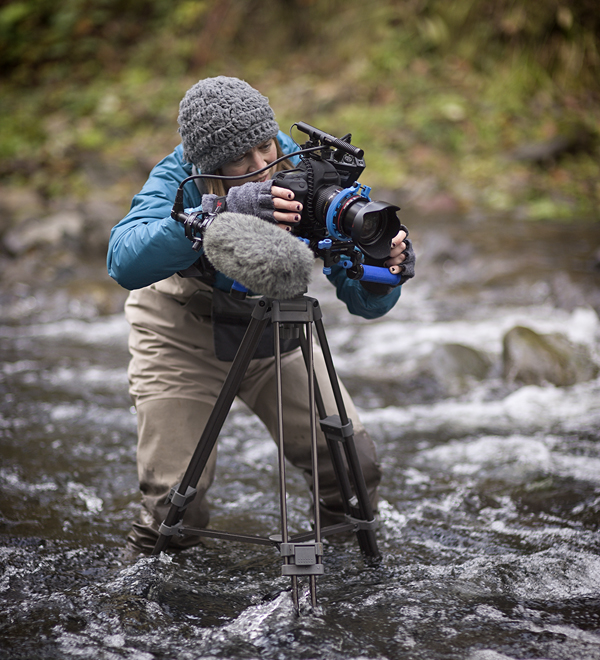Excellent news from the great Beaver Beyond, where Sarah Koenisberg has been working hard putting the finishing touches on her Beaver Believer Film. I can barely remember years ago when she came to the the festival and filmed the long interview in my backyard. She’s been working nonstop ever since. And supposedly the film is ready to be released on the film festival circuit.
Beyond the Pelt
Washington-based filmmaker Sarah Koenigsberg was getting tired of all the apocalyptic doom-and-gloom climate change stories floating around the media circuit when she happened upon an unlikely glimmer of hope: beavers. After filming these ecosystem engineers for her own feature-length documentary, “The Beaver Believers,” she helped the Trust produce a short film showcasing three success stories of how the return of beavers has transformed public lands across the West. Here, we talk to Sarah about beavers, activism, and catching the slippery critters on camera.
Most people know beavers build dams, but how do they help address climate change?
Beaver dams create ponds and wetlands that collect precipitation, letting it sink slowly into the ground instead of rushing straight out to the ocean. In the arid Southwest, this water storage is incredibly valuable, as it recharges the aquifer and holds water underground until it can slowly trickle back into our streams. Local wildlife, spawning fish, and migrating birds also thrive in the pockets of diverse habitat that beavers help build. The list goes on!
What is next in the queue?
I’m in the final stages of post-production on my film “The Beaver Believers,” which is really exciting. I had something like 70 hours of footage shot over two years for this 50-minute film. You can learn more about that project and watch our trailer at www.thebeaverbelievers.com. We’ll begin entering it into film festivals this spring!
Martine z is part of those 70 hours and I’m hoping something of us made it past the cutting room floor! I know that she included part of Mark Comstock’s beaver ballad because she wrote once that she had gotten it stuck in her head after editing footage with it again and again. Gosh, that seems like a long time ago. In 2013 we had three kits and one yearling from our new mom who had been around just over a year.
z is part of those 70 hours and I’m hoping something of us made it past the cutting room floor! I know that she included part of Mark Comstock’s beaver ballad because she wrote once that she had gotten it stuck in her head after editing footage with it again and again. Gosh, that seems like a long time ago. In 2013 we had three kits and one yearling from our new mom who had been around just over a year.
I remember that thursd ay, they drove here after filming Suzanne Fouty and Carole Evans in Nevada. I spoke at Kiwanis that day and came home to be interviewed
ay, they drove here after filming Suzanne Fouty and Carole Evans in Nevada. I spoke at Kiwanis that day and came home to be interviewed  for another 7 hours before having them to dinner. Friday was the usual insane packing for the festival and I barely saw anyone at the event because we were all working so hard. They headed off in their movie-making horse trailer that evening. To hit the next target for inclusion.
for another 7 hours before having them to dinner. Friday was the usual insane packing for the festival and I barely saw anyone at the event because we were all working so hard. They headed off in their movie-making horse trailer that evening. To hit the next target for inclusion.
And now the film is getting finishing touches and then shipping out. Go read the whole thing and learn how and why Sarah does what she does. I wonder if it is headed for the Wild and Scenic Film Festival in Nevada where Ian’s went. It would be fun to have them close to home and start a whole beaver genre to that event!
The Beaver Believers Kickstarter Trailer from Tensegrity Productions on Vimeo.
Yesterday, we heard the exciting news that Jeremy Fish’s amazing artwork was finished after being temporarily matted by founding member of the Martinez Arts Association Cathy Riggs of “I’ve been Framed” downtown. She didn’t charge us a penny but clearly spent hours on it, using contrasting mats to pick up the colors. I sent the photo to Mr. Fish who was very impressed. I know it will be a hot item at the auction, and you’ll probably want to come bid on it yourself. Thanks so much Cathy!










 eanup of the river by dredging portions of the riverbed and shoreline. GE is presently fighting this action on various legal, logistical and technical grounds
eanup of the river by dredging portions of the riverbed and shoreline. GE is presently fighting this action on various legal, logistical and technical grounds te their dams.
te their dams.









































